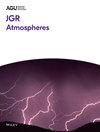The atmospheric circulation in the northern hemisphere interacts with that in the southern hemisphere mainly via lateral coupling and atmospheric mass exchanges across equator. Using the NCEP-NCAR daily reanalysis over period 1979–2019, we examine the Inter-Hemispheric Oscillation (IHO) on the synoptic timescale during boreal winter and its associations with Rossby waves by employing a 9-day high-pass filter and the time-lag regression method. Our results demonstrate that the IHO exist in the surface air pressure anomalies on synoptic timescale which links to both the quasi-stationary and migratory Rossby waves with large amplitudes in the mid- and high- latitudes from the troposphere up to the stratosphere. The synoptic-IHO related quasi-stationary waves appear mainly in zonal, roughly dominated by waves with wave-number 1–7 at different latitudes. These waves disperse the wave energy eastward along westerly jet streams. On the other hand, the synoptic-IHO related migratory Rossby waves are mainly observed in mid latitudes between 30°N–65°N and 30°S–60°S with stronger intensity in northern than in southern hemisphere. The phase speed of these waves is roughly estimated at about 9.5lon/d. The energy of intrinsic Rossby waves also propagates mainly eastward. The synoptic-IHO has important impacts on surface air temperature via both the quasi-stationary and migratory Rossby waves, inducing significant temperature changes over both Eurasian continent and North America as estimated from 40 winters. All the results are beneficial for us to better understand the IHO along with its interaction with Rossby waves and the formation mechanisms of cold weather and climate extremes during boreal winter.


